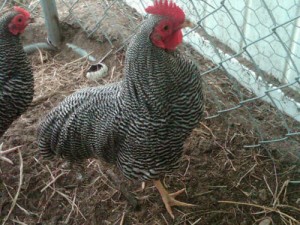First Aid Chicken Kit
Occasionally there arises a time when there is the need to administer first aid to your chickens. Perhaps a run in with the wire gate scratched your chicken’s leg or wattle. Maybe the neighbor’s dog or a raptor bit your hen on the wing. These are times when having a handy kit at hand will help you give first aid to your chooks.
The trauma part of first aid is a lot like a kit you may find for yourself. Simple stretch gauze, gauze pads, tape, antibiotic ointment are a few necessities. These are good for cuts and bites. Of course, scissors would help greatly, especially the ones with the blunt ends for first aid work to avoid cutting something that isn’t supposed to be cut. In the event of a wound applying some antibiotic cream and a bandage of gauze and stretchy tape may make a big difference in your chickens’ health and recovery.
Wheat flour may come in handy for covering a wound to prevent it from bleeding further. Commercial sprays are also available. Iodine works well as an antibiotic. A hand held spray bottle with wound spray will help treat open wounds. Salt added a teaspoon to a cup of water is sufficient if mixed with warm water to help dissolve it.
Antibiotic medication may be another thing to consider having on hand. It should not be administered as a preventative or it may cause the bad stuff to become immune to the antibiotics.
Sulfamed and other similar drugs are good for coccidiosis and other similar diseases. One should only give medication to the bird if they know or have a great reason to know what the ailment is. Giving it for prevention or guesswork shouldn’t be done.
Anti pecking spray might be a good thing to have if you have a lot of birds, or if you have a lot of chicks in a brooder. Spraying the bloody part will keep the other birds from pecking at the distressed chicken until it can heal.
A syringe may come in handy in case you need to feed a bird that isn’t eating. It can mean the difference between life and death in some instances. Placing liquefied food in the syringe and feeding the bird manually can be hard if they fight you and squirm around a lot. Wrapping a bird in a towel can help greatly. Feeding or administering water too fast, or for too long can drown or choke an animal. Use caution when manually feeding the chicken.
The same syringe with a bit of aquarium tubing can aid in flushing a compacted crop. It also can be used to give water or medication. Pushing the tube gently about three-fourths of the way down the throat is usually sufficient. Once again the bird will probably not like this and will fight it. Wrap in a towel and hold firmly to make it go easier.
Saline solution is good for getting debris out of an avian eye. Most bottles of saline solution have a nozzle tip that aids greatly in removing dirt and other foreign items out. Saline solution can also be used to clean cuts of dirt and debris as well.
Some of these items can be hard to locate, especially when you are busy doing something at the last minute and notice that your bird is drooping its wings, or has a cut leg that is bleeding.
After giving treatment or first aid to the bird they may benefit more from being set aside from the rest of the population. This may be another cage or coop separate from the general population of birds. Perhaps a sick house may mean a cardboard box or a cat carrier. Occasionally a bird needs to be separated to help it get healthy faster.
Dog clippers come in handy for removing the tips of spurs on a rooster and for clipping a chicken’s toenails if they aren’t being worn from day to day activity.
Don’t take it for granted or expect that nothing will ever happen. These sorts of things pop up from time to time among the best cared for birds. An ounce of prevention is worth a pound of cure, but success favors the prepared.
This article isn’t meant to be an end-all. If you have problems with your poultry and use this guide remember it is only a guide. There is a multitude of avian ills. Many of them are minor, but some of them are not to be taken lightly. Common remedies like those outlined in this article have been around for a long time, and these remedies have as well. However, we make no warranty or guarantee implied or expressed that they should take the place of a qualified avian veterinarian. These remedies have been gathered from vets, poultry keepers, and experienced breeders, but do not replace a veterinarians care.
 Hobby Poultry A Chicken in Every Yard
Hobby Poultry A Chicken in Every Yard 